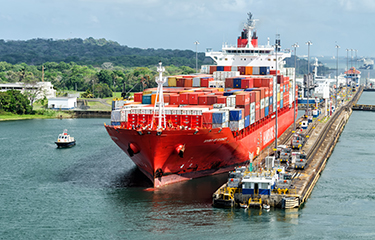The Panama Canal, through which 40 percent of container traffic from Asia to Europe travels, is predicted to see unprecedented congestion in the lead-up to the year-end holiday season.
A historic drought in Panama has slowed down traffic through the canal, with restrictions imposed on ship draft and the number of vessels allowed to make the crossing due to water conservation regulations. As a result, the average wait time to use the canal has increased to 10 to 11 days in August, which is up from 6 to 7 days in July, Reuters reported.
Christian Roeloffs, the CEO of shipping logistics firm Container xChange, said recent lackluster consumer demand is likely to rebound in advance of the holidays, ramping up the pressure on the Panama Canal Authority figure out a way to accommodate the increased traffic.
“These supply chain disruptions are expected to reverberate throughout the industry, with potential consequences for container prices," Roeloffs said. "The ongoing congestion and reduced capacity have led to heightened competition for available slots, driving up spot freight rates."
There is also a scarcity of available vessel capacity, prompting carriers to "reevaluate pricing strategies to offset increased costs and uncertainties," Roelofs said.
"Consequently, the traditional equilibrium of container prices may experience adjustments to accommodate the challenges of the Panama Canal congestion," he said.
Abe Eshkenazi, the CEO of the Chicago, Illinois, U.S.A.-based Association for Supply Chain Management, told Retuers
"If you're talking about a long-term disruption that could go into the fall, as a shipper I'm going to find a different alternative for my product if I can't count on getting through the [Panama Canal's] locks in a reasonable time," Eshkenazi said.
Vincent Clerc, the CEO of A.P. Moller-Maersk, one of the world's largest shipping companies, said in early August he is not as convinced about a global economic recovery taking place this year.
"We had expected customers to draw down inventories around the middle of the year, but so far we see no signs of that happening. It may happen at the beginning of next year," Clerc said, according to Reuters. "Consequently, the uptick in volumes we had expected in the second half of the year has not occurred."
A.P. Moller-Maersk's volumes could fall by as much as 4 percent in 2023, Clerc warned. And worsening the situation is the fact that hundreds of new container vessels ordered during the height of the pandemic, when global demand for consumer goods exploded, are now coming online.
"Most of the orders are still in the shipyard, so we have a long haul in front of us," Clerc said.
Photo courtesy of BlackMac/Shutterstock







